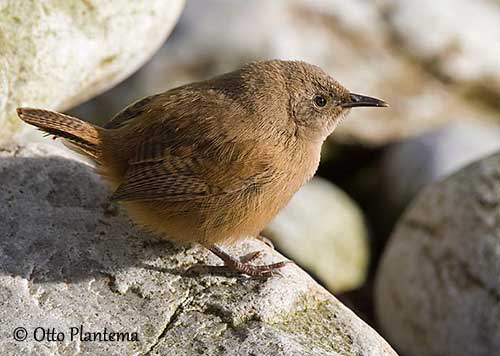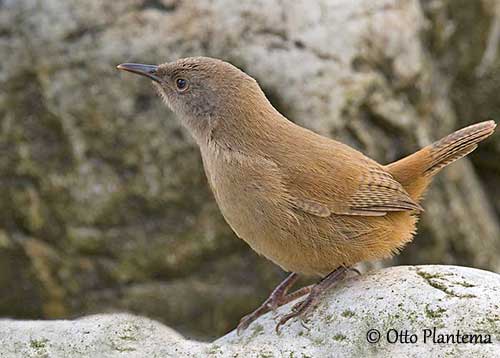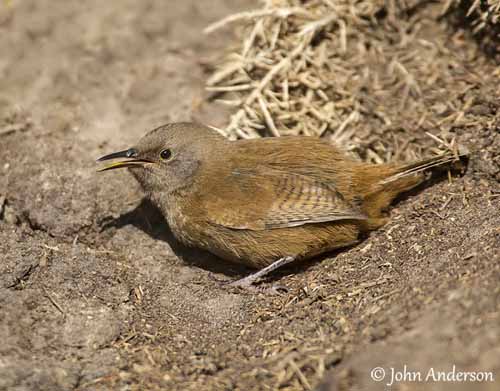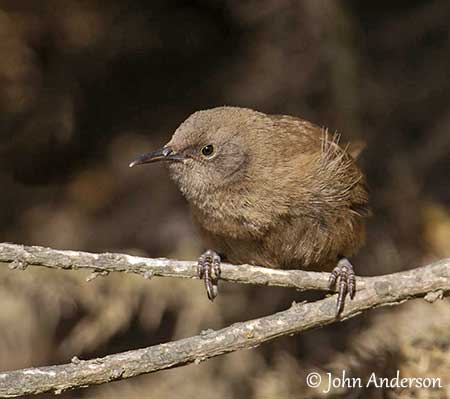
Fr: Troglodyte de Cobb
All: Falklandzaunkönig
Esp: Chochín Malvinero
Ita: Scricciolo di Cobb
Nd: Cobbs Winterkoning
Sd: Falklandsgärdsmyg
Photographers:
John Anderson
John Anderson Photo Galleries
Otto Plantema
Trips around the world
Text by Nicole Bouglouan
Sources:
HANDBOOK OF THE BIRDS OF THE WORLD Vol 10 by Josep del Hoyo-Andrew Elliott-David Christie - Lynx Edicions - ISBN: 8487334725
WRENS, DIPPERS AND THRASHERS by Brewer David – illustrated by Barry Kent Mackay- Yale University Press - ISBN: 0300090595
BirdLife International (BirdLife International)
Protecting the wildlife of the Falkland Islands
Cobb’s Wren
Troglodytes cobbi
Passeriformes Order – Troglodytidae Family
INTRODUCTION:
The Cobb’s Wren name pays tribute to Arthur F. Cobb, born in Falkland Islands in 1877. He collected the first specimen in 1908 on Carcass Island, NW of W Falklands. This species was described as a new species, and was confirmed in 1993 as endemic species to Falkland Islands with the Falkland Steamerduck.
DESCRIPTION OF THE BIRD:
Biometrics:
Length: 13-14 cm
Weight: 17-20 g
On the upperparts, crown and nape are grey-brown, becoming warmer brown on back and scapulars, and brighter rusty-brown on rump. On the upperwing, the outer webs of primaries and secondaries are barred dark grey and brown. The tail feathers are brown, narrowly barred dark grey.
The underparts are grey-brown, with paler centres of throat and upper breast, becoming warmer on flanks and vent.
On the head, lores, cheeks and ear-coverts are grey-brown and unmarked.
The bill is blackish. The eyes are brown. Legs and feet are dark brown.

Both sexes are similar.
The juvenile has buff underparts.
Partial albinism in this species is quite common, with some white or greyish patches on head and body, probably due to inbreeding within the small population.
RANGE:
The Cobb’s Wren occurs on small offshore islands in Falkland Islands.
HABITAT:
The Cobb’s Wren usually frequents dense tussac grass (Paradiochloa flabellata), a tall grass species typical of Falklands. This plant grows from high water mark behind a rocky beach, where dead kelp and sea weeds are accumulated. Numerous invertebrates thrive in this type of soil.
CALLS AND SONGS: SOUNDS BY XENO-CANTO
The call of the Cobb’s Wren includes harsh and buzzy trills, “chiz” or “cheez”. When the bird is excited, these notes become higher-pitched and explosive.
The song is a loud phrase including rapid trills and whistles, mixed with low buzzy sounds. The male sings from exposed perch such as rock, or completely hidden among the grass. The song may vary in motif according to individual males.

REPRODUCTION OF THIS SPECIES:
The breeding season occurs between October and December.
The nest is egg-shaped, with a side entrance pointing slightly upwards. It is made with tussac grass and seal hairs. The inner cup is covered with a thick lining of feathers. It is often placed on or close to the ground, at base of grass clump, below rocks or in rock crevice, at 90 centimetres maximum height above the ground.
The female lays 3-4 pinkish eggs with heavy red markings. No information on incubation and fledging periods.
This species can produce two broods per year.
PROTECTION / THREATS / STATUS:
The Cobb’s Wren has very restricted range on small islands. It is vulnerable to habitat destruction, and heavily threatened by introduced predators such as cats and rats.
The population has been estimated in 2008 at 9,000/16,000 individuals, or 6,000 pairs.
This species is currently classified as Vulnerable.
BEHAVIOUR IN THE WILD:
The Cobb’s Wren feeds on small invertebrates such as insects, sea lice (small parasitic crustaceans) and camel crickets (Rhaphidophoridae). The chicks are fed on moth larvae.
It forages among the tussac grass and the washed-up sea weeds on beaches. It also searches for preys in crevices in boulders.
This species is very tame and often feeds close to people on beaches. If disturbed, it vanishes silently in tussac grass, rather than to take-off and fly away.
The male sings mainly from late August to November, and less frequently to April. They are very territorial during the breeding season, and they usually use the same territory every year.
There is no information on courtship displays. But we can suggest that the male sings loudly, builds more than one nest, and displays with the tail cocked over the back.
The Cobb’s Wren is sedentary. Some inter-islands movements are reported, but only between the closest islands, always over short distances.

